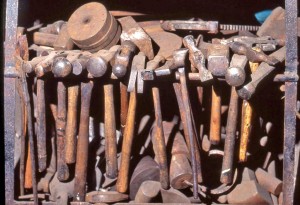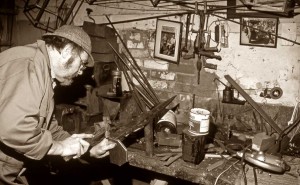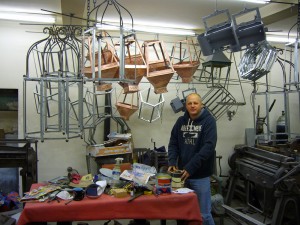In a cluttered workshop in Edinburgh’s New Town, Lonsdale & Dutch still uses traditional methods to create the lanterns of the past.
 Time stops and history speaks from every corner of the jumbled Edinburgh workshop which dates back to the 1800s.
Time stops and history speaks from every corner of the jumbled Edinburgh workshop which dates back to the 1800s.
Heavy hulks of Victorian machinery, reminiscent of laundry mangles and industrial mincing machines, jostle for space with modern welding equipment and tall oxygen bottles.
Wooden benches boast a litter of wicked shears, anvils, vices and saws. The walls are hung with ancient lineages of brass callipers and soldered bolts.
Above it all, dangling from countless butcher’s hooks, are skeletons of the lanterns and lamps that are made here: A geometric puzzle of metal frames waiting to be painted, polished and displayed in the most splendid of interiors.
 A sheet metal workshop has been at this location in Howe Street, Edinburgh, since the 1860s. In 1921 the premises were taken on by Mssrs Dutch and Lonsdale.
A sheet metal workshop has been at this location in Howe Street, Edinburgh, since the 1860s. In 1921 the premises were taken on by Mssrs Dutch and Lonsdale.
While Mr Dutch remained and developed the business, the story goes that Mr Lonsdale was only in Scotland for a few months and then went back to the USA. As, in those days, it was too expensive to get the songwriters back, the name ‘Londsdale & Dutch’ stuck, and exists to this day.
By the 1960s, Arthur Dutch was employing twelve men, much of their work being metalwork repairs for motor cars (Arthur’s father had worked for Moir & Baxter’s garage, about a mile away at Comely Bank).
By the 1990, Arthur Dutch, grandson of the original owner, had been working on the premises for over 40 years; by then working on his own, specialising in making lanterns to order. Business was good – there was no shortage of orders and and he had no time to make any for stock.
When Arthur Dutch retired in 1997, Rodney French took over the business. Rodney trained in the curators’ department of the National Trust for Scotland and many of his commissions have been for National Trust properties, including 137 lights for for their Head Office in Charlotte Square.
 At Lonsdale and Dutch, Rodney French continues to work using traditional methods. He uses Victorian machinery as well as modern welding equipment.
At Lonsdale and Dutch, Rodney French continues to work using traditional methods. He uses Victorian machinery as well as modern welding equipment.
In the back shop is the forge where iron is hammered into points and scrolls. Sheet metal is cut on a guillotine more than 100 years old. The guillotine must have cut thousands of miles of material and the blade has never been sharpened.
Nothing gets forced on the machines as it is always in the back of the mind that they cannot be replaced.
Architects, developers and private customers still patronise the workshop and Rodney is happy to adapt traditional designs to suit customer needs.
Photo Gallery


















